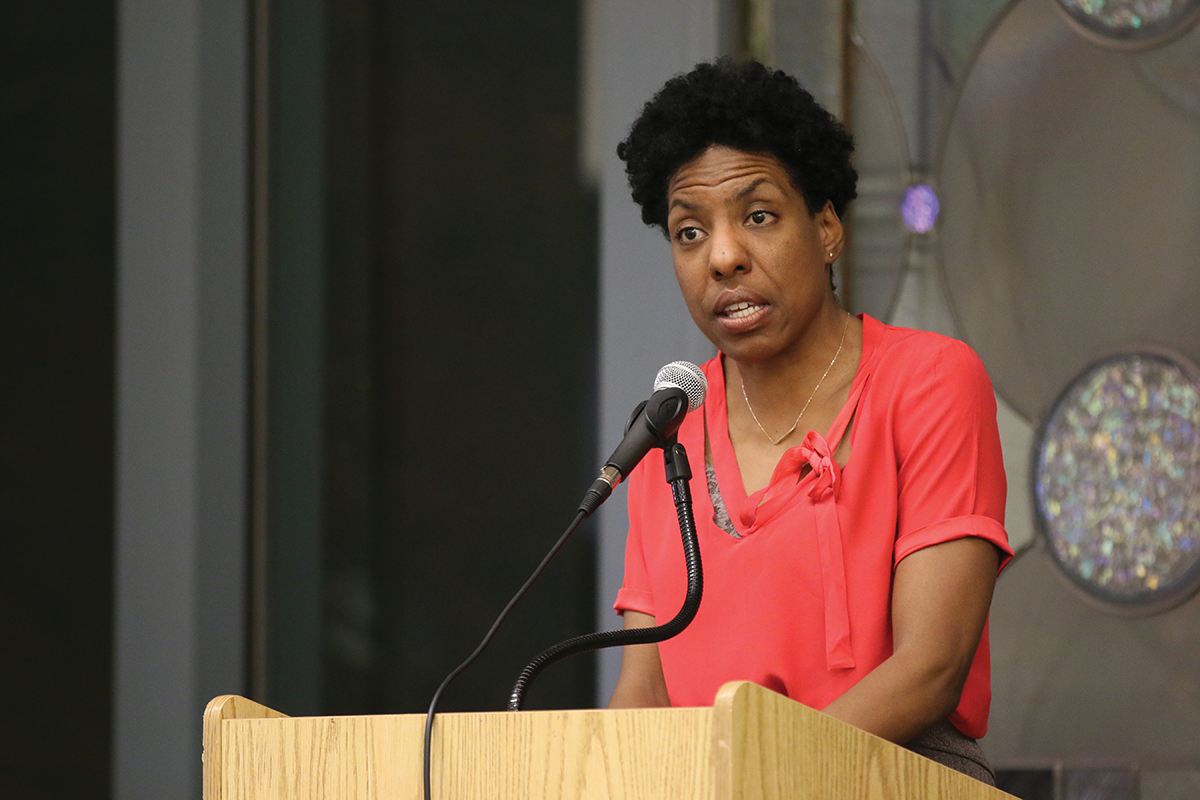
by Sharon Luk, Assistant Professor, UO Department of English
I would like to preface my comments by quickly situating myself as a reader: first, as a woman of color who turns to books like this out of a need for validation and for wisdom; through the courage of our artists, to have my feelings and experiences clarified in a way that’s impossible to clarify on my own. Second, I come to this book also as a scholar, someone whose life’s work has become not just appreciating books but, inevitably and over time, starting to read each book as part of different genealogies of thought that span centuries, intellectual traditions, and historical struggles. So, at the crossroads of both these positionalities, for me, the achievement of this book resides not only in the singularity or integrity of its own self-contained universe, but also in the challenges I imagine the artist must face in finding a unique place for her work within the densest matrix of every story and every struggle that has preceded her own. What a daunting task! And for The Twelve Tribes of Hattie, I see furthermore at least two particular challenges.
One: Mathis has, in significant ways, chosen to take on the dilemmas of racialized maternity, which, to my mind, is very difficult at this point in time to do well. On the one hand, across women of color feminisms of all ethno-racial foundations, the problem of systematic violence and its effects on matriarchy and kinship are so fundamental to everything we think, do, and become; and as such, on the other hand, a relative abundance of our literatures have addressed these problems and hence, over time, the discourses can become to some degree canonized or formulaic, adding pressure to the task to create so-called “original” work. And two: having delivered to us this breathtaking book, when I googled Ayana Mathis to get a sense of the “Ayana Mathis,” I kept reading over and over again comparisons to Toni Morrison. (OK, let me just say that if that were me I’d be ready to go to the grave since, seriously, is there any greater achievement in life?) But that’s also to say, such comparison returns to the simultaneous honor and profound challenge of the artist’s creative dilemma, in which every word you write is inextricably bound up with the legacy of your elders and ancestors and a reflection of the seemingly limitless intellectual heritage you hope to represent in all its richness. That is a lot to carry….and to carry with at least the appearance of grace.
And so, in that sense, “comparisons,” if you can call it that—perhaps more precisely it may be called an inheritance, expressing itself most immediately as a likeness but containing within it an irreducible difference—this inheritance is indeed inescapable, surviving even our own greatest attempts to disavow or distance from it. Finally, then, it is within this context that as I read The Twelve Tribes of Hattie, its uniqueness and its elegance simultaneously evoked for me the uniqueness and elegance of other works of Black feminist art I felt that Mathis paid tribute to and made proud; and the more revelatory and expansive the originality of this work, chapter after chapter, in my eyes only the more connected rather than separate it became to the past and, in a way, to the future too. All this is by way of coming back to this passage I selected—I promise! But maybe the point is that getting there necessitates taking the long road.
To get there, first, I think we have to go through what happens stylistically in this work, the way that through each of the twelve tribes, the figure of Hattie becomes not only present to us but the very center of gravity of the entire universe of the book; and yet, in the final instance, the economy of the narrative structure—which is also to say, the limits of representation of the subject—renders Hattie’s subjectivity fundamentally inaccessible to us, undeniably opaque in a way that, from the very title of the book, reminded me of a tradition of radical negation in Black feminist thought and literature. For me, perhaps one of the most shining examples of this trajectory within twentieth-century literary art is the work of Jamaica Kincaid, and my imagination took a palpable turn to her novel, The Autobiography of My Mother, which ends, “This account of my life has been an account of my mother’s life as much as it has been an account of mine, and even so, again it is an account of the life of the children I did not have, as it is their account of me…This is the account of the person who was never allowed to be and an account of the person I did not allow myself to become.” What a stunning and paradoxical refusal, both to disarticulate from the maternal trace and, more viscerally and to put bluntly, to “get over it.”
But, of course, this is not to suggest that The Twelve Tribes of Hattie is somehow merely derivative of such precedents—or, let’s say more precisely, that if this work is descended from, itself also touched by a certain maternal trace that cannot be refused or gotten over, that it is not merely some ritual repetition of past work. For instance, in this world of meaning Hattie moves closer towards the limits of becoming, even if she remains unknowable to us. For another thing, there are twelve others, not just children, but tribes, a social multiplicity contextualized by the epigraph from Deuteronomy “…and I selected twelve of you, one from each tribe.” Deep within the realms of Black negativity, then, we are presented with an amalgam of subjectivities, the infinite complexities of each of their inner lives and the extensive reach of their interconnectedness with each other and with history: all of which comes back to the singular, simultaneously self-obvious and unfathomable presence of the working-class African American maternal figure, the inner sociality of Black female subjectivity at the crossroads of subject and object.
One last detour, then, before we come back to the passage at hand. The novel begins with Philadelphia and Jubilee—begins in some ways with absolutely no mercy as we are introduced to a woman, at the doorstep of imagined opportunity, instead condemned to the grief magnetized by Black maternity, failed in her struggles to help her newborns survive the brutalities of this world. In this sense, Philadephia and Jubilee’s deaths, the scar of their absence marking from the outset the hyper-visibility of Hattie’s condition of being broken, did to my mind and in a very immediate way bring Toni Morrison’s energy to this book. Specifically, I went to the inscrutable Black femininity epitomized by Sula, a title character herself drawn from the inheritance of Blues women, in which Morrison presents to us, without apology or qualification, the self-identified “strangeness” of Black female subjectivity arising as “the consequence of an idle imagination...and like any artist with no form she became dangerous.” In Hortense Spillers’ meditation on the significance and signification of Sula, Spillers thus reflects that “her audience is forced to accept the corruption of absolutes and what has been left in their place: the complex, alienated, transitory gestures of a personality who has no framework of moral reference beyond or other than herself…Sula is Morrison’s deliberate hypothesis.” And so, likewise, we are given this presentation of Hattie as perhaps Mathis’s deliberate hypothesis—a Black maternal figure whose imagination has been rendered idle and whose art of caring has been rendered formless, the fatal force of racism not affording Hattie the luxury of moral reference beyond or other than herself; and yet, nevertheless still conceived of as not only a survivor but incumbent matriarch of the remaining tribes and each of their own struggles towards fulfilling the promise and the prophecy of freedom. From this perspective, even as Rita Dove’s words appear alongside Deuteronomy in the book’s epigraph to remind us that “The house, shut up like a pocket watch,/those tight hearts breathing inside—/she could never invent them,” we are confronted in the working through of a hypothesis that is Hattie with a new problematic, one emerging out of the fundamental ambivalence between where Hattie ends and her tribes begin: that is, if she could not invent them, will they or their tribes indeed, have invented her? This question arguably haunts each of the chapters, felt as unfulfilled and unfillable desire that animates or colors Hattie’s presence in the simultaneity of her being and undoing.
At last, then, in the story of Six, we are given over to human revelation in the burn of what will always remain broken, scarred, ultimately unfixable—Six in the clouded and grainy light, unable even to find his pants; unsure of what town he’s in or in whose house he has passed out; shamed by his scars and the nakedness of his own damage. And in the absence of a mode of recovery or reconciliation in which we’re supposed to master an art of “getting over it”—which means getting over the heritage of our mothers in order to avail ourselves to the spoils of white supremacy—in the inability or refusal to do so, in all this brokenness, emerges this calling towards life’s mystery that, despite every conceit of human mastery, absolutely cannot be controlled or disavowed and is made manifest in Reverend Grist’s affirmation of the gift and work of art that itself ultimately cannot be repressed. And so, in the intersubjectivity of Hattie and Six, the mother in terror and the boy caught in the vast array of his earthly displacements, we are ultimately reminded in this passage of the terrible beauty, the brutal tenderness, residing in the interwovenness of Black maternity, kinship, art, and prophetic tradition through which Black life and its universal force are still becoming, and guided by a yet unknown form of Power, which in the final instance is only reinforced rather than overturned by what is held in the hands of Hattie and Cassie without need for intercession, contains within it the living promise of an impossibility made flesh. For this most urgent lesson and example in what Fred Moten calls “making an art of making art,” Ayana Mathis, we celebrate and thank you.

